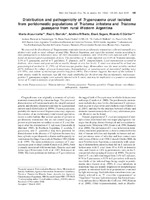Please use this identifier to cite or link to this item:
http://sgc.anlis.gob.ar/handle/123456789/286| DC Field | Value | Language |
|---|---|---|
| dc.contributor.author | Lauricella, Marta A. | es |
| dc.contributor.author | Stariolo, Raúl L. | es |
| dc.contributor.author | Gürtler, Ricardo E. | es |
| dc.contributor.author | Segura, Elsa L. | es |
| dc.contributor.author | Riarte, Adelina | es |
| dc.date.accessioned | 2012-10-30T14:06:00Z | - |
| dc.date.available | 2012-10-30T14:06:00Z | - |
| dc.date.issued | 2005 | - |
| dc.identifier.issn | 0074-0276 | - |
| dc.identifier.uri | http://sgc.anlis.gob.ar/handle/123456789/286 | - |
| dc.identifier.uri | http://www.ncbi.nlm.nih.gov/pmc/articles/PMC3076212/pdf/nihms-74939.pdf | - |
| dc.description | We assessed the distribution of Trypanosoma cruzi infection in peridomestic triatomines collected manually at a district-wide scale in rural villages around Olta, Western Argentina, and typed the isolated strains according to their pathogenicity to laboratory mice. Of 1623 triatomines examined, only 14 (0.9%) were infected with T. cruzi based on microscopical examination of feces. The prevalence of T. cruziinfection was 0.8% in Triatoma infestans, 2.3% in T. guasayana, and nil in T. garciabesi, T. platensis, and T. eratyrusiformis. Local transmission occurred in kitchens, store-rooms and goat corrals or nearby, though at very low levels. T. cruzi was detected by at least one parasitological method in 11 (79%) of 14 microscope-positive bugs. Hemoculture was the most sensitive method (67%) followed by culture of organ homogenates, histopathology or xenodiagnosis of inoculated suckling mice (55-58%), and culture of microscope-positive bug feces (46%). The evidence suggests that most of the isolated T. cruzistrains would be myotropic type III. Our study establishes for the first time that peridomestic, microscope-positive T. guasayananymphs were actually infected with T. cruzi, and may be implicated as a putative secondary vector of T. cruziin domestic or peridomestic sites. | en_US |
| dc.description | Fil: Lauricella, Marta A. ANLIS Dr.C.G.Malbrán. Instituto Nacional de Parasitología Dr. Mario Fatala Chaben; Argentina. | en_US |
| dc.description | Fil: Stariolo, Raúl L. Coordinación Nacional de Control de Vectores; Argentina. | en_US |
| dc.description | Fil: Segura, Elsa Leonor. ANLIS Dr.C.G.Malbrán. Instituto Nacional de Parasitología Dr. Mario Fatala Chaben; Argentina. | en_US |
| dc.description | Fil: Riarte, Adelina Rosa. ANLIS Dr.C.G.Malbrán. Instituto Nacional de Parasitología Dr. Mario Fatala Chaben; Argentina. | en_US |
| dc.description | Fil: Gürtler, Ricardo E. Universidad de Buenos Aires. Laboratorio de Eco-Epidemiología; Argentina. | en_US |
| dc.format | application/pdf | ES |
| dc.language.iso | eng | en_US |
| dc.rights | info:eu-repo/semantics/openAccess | en_US |
| dc.source | Memórias do Instituto Oswaldo Cruz, 2005, 100(2), 123–129. | en_US |
| dc.subject | Enfermedad de Chagas | en_US |
| dc.subject | Trypanosoma cruzi | en_US |
| dc.subject | Triatoma | en_US |
| dc.subject | Virulencia | en_US |
| dc.subject | Argentina | en_US |
| dc.title | Distribution and pathogenicity of Trypanosoma cruzi isolated from peridomestic populations of Triatoma infestans and Triatoma guasayana from rural Western Argentina | en_US |
| dc.type | Artículo | es |
| dc.coverage | ARG | en_US |
| anlis.essnrd | 1 | es |
| item.languageiso639-1 | en | - |
| item.grantfulltext | open | - |
| item.openairetype | Artículo | - |
| item.cerifentitytype | Publications | - |
| item.fulltext | With Fulltext | - |
| item.openairecristype | http://purl.org/coar/resource_type/c_18cf | - |
| Appears in Collections: | snrd Publicaciones INP | |
Files in This Item:
| File | Description | Size | Format | |
|---|---|---|---|---|
| MemóriasdoInstitutoOswaldoCruz,2005,100(2),123–129..pdf | 77.15 kB | Adobe PDF |  View/Open |
Page view(s)
182
checked on Jan 12, 2026
Download(s)
82
checked on Jan 12, 2026
Google ScholarTM
Check
Items in DSpace are protected by copyright, with all rights reserved, unless otherwise indicated.

